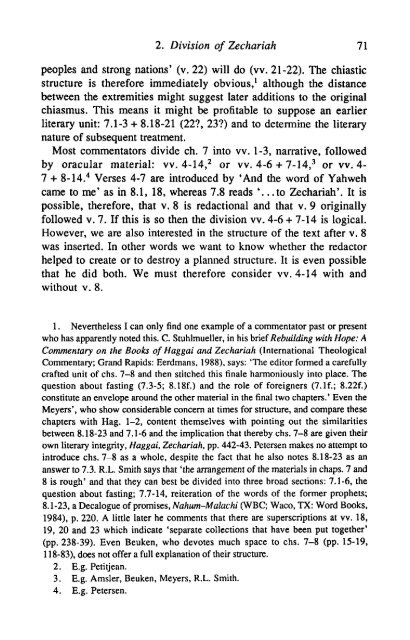130. - Collection Point® | The Total Digital Asset Management System
130. - Collection Point® | The Total Digital Asset Management System
130. - Collection Point® | The Total Digital Asset Management System
You also want an ePaper? Increase the reach of your titles
YUMPU automatically turns print PDFs into web optimized ePapers that Google loves.
2. Division of Zechariah 71<br />
peoples and strong nations' (v. 22) will do (vv. 21-22). <strong>The</strong> chiastic<br />
structure is therefore immediately obvious, 1 although the distance<br />
between the extremities might suggest later additions to the original<br />
chiasmus. This means it might be profitable to suppose an earlier<br />
literary unit: 7.1-3 + 8.18-21 (22?, 23?) and to determine the literary<br />
nature of subsequent treatment.<br />
Most commentators divide ch. 7 into vv. 1-3, narrative, followed<br />
by oracular material: vv. 4-14, 2 or vv. 4-6 + 7-14, 3 or vv. 4-<br />
7 + 8-14. 4 Verses 4-7 are introduced by 'And the word of Yahweh<br />
came to me' as in 8.1, 18, whereas 7.8 reads '. ..to Zechariah'. It is<br />
possible, therefore, that v. 8 is redactional and that v. 9 originally<br />
followed v. 7. If this is so then the division vv. 4-6 + 7-14 is logical.<br />
However, we are also interested in the structure of the text after v. 8<br />
was inserted. In other words we want to know whether the redactor<br />
helped to create or to destroy a planned structure. It is even possible<br />
that he did both. We must therefore consider vv. 4-14 with and<br />
without v. 8.<br />
1. Nevertheless I can only find one example of a commentator past or present<br />
who has apparently noted this. C. Stuhlmueller, in his brief Rebuilding with Hope: A<br />
Commentary on the Books of Haggai and Zechariah (International <strong>The</strong>ological<br />
Commentary; Grand Rapids: Eerdmans, 1988), says: '<strong>The</strong> editor formed a carefully<br />
crafted unit of chs. 7-8 and then stitched this finale harmoniously into place. <strong>The</strong><br />
question about fasting (7.3-5; 8.18f.) and the role of foreigners (7.If.; 8.22f.)<br />
constitute an envelope around the other material in the final two chapters.' Even the<br />
Meyers', who show considerable concern at times for structure, and compare these<br />
chapters with Hag. 1-2, content themselves with pointing out the similarities<br />
between 8.18-23 and 7.1-6 and the implication that thereby chs. 7-8 are given their<br />
own literary integrity, Haggai, Zechariah, pp. 442-43. Petersen makes no attempt to<br />
introduce chs. 7-8 as a whole, despite the fact that he also notes 8.18-23 as an<br />
answer to 7.3. R.L. Smith says that 'the arrangement of the materials in chaps. 7 and<br />
8 is rough' and that they can best be divided into three broad sections: 7.1-6, the<br />
question about fasting; 7.7-14, reiteration of the words of the former prophets;<br />
8.1-23, a Decalogue of promises, Nahum-Malachi (WBC; Waco, TX: Word Books,<br />
1984), p. 220. A little later he comments that there are superscriptions at vv. 18,<br />
19, 20 and 23 which indicate 'separate collections that have been put together'<br />
(pp. 238-39). Even Beuken, who devotes much space to chs. 7-8 (pp. 15-19,<br />
118-83), does not offer a full explanation of their structure.<br />
2. E.g. Petitjean.<br />
3. E.g. Amsler, Beuken, Meyers, R.L. Smith.<br />
4. E.g. Petersen.






